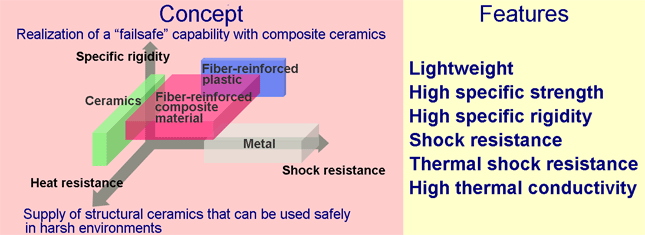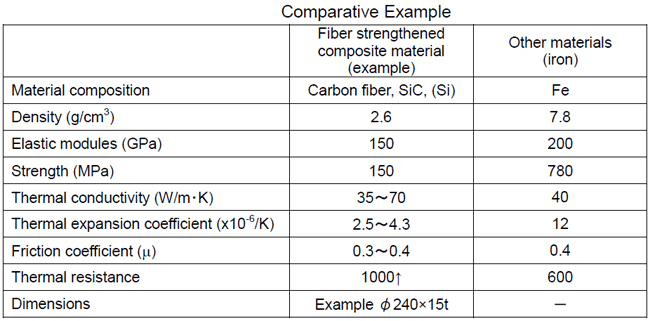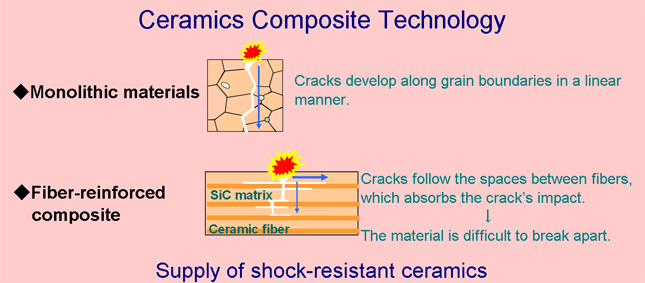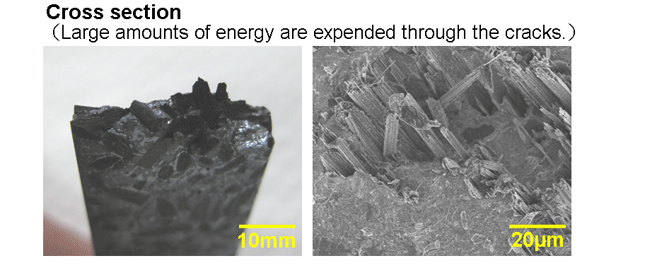CoorTek has developed a composite ceramic material using silicon carbide (SiC) and short carbon fibers. It has the lightweight and heat-resistant characteristics of ceramic, yet it overcomes ceramic’s brittleness with the addition of carbon fibers for reinforcement. This quasi-ductile fracture behavior achieves “crack control ceramics”.

- Lightweight, high specific strength and high specific rigidity
-
The weight of this composite material is half or less than those of heat-resistant metal alloys and iron. It features very high specific strength and very high specific rigidity. Therefore it can contribute to size and weight reduction in structural parts.
- Resistance to shocks and heat
-
The material can be used in high thermal shock environments over 1000 °C, which conventional monolithic ceramics cannot tolerate because they would crack. Silicon carbide and carbon fibers make our composite material resistant to such high temperatures.
- Low cost, mass production
-
For greater cost efficiency and higher productivity than conventional composites, matrices are made by special method.

- Composite technology
-
Cracks develop from external mechanical shocks. In ceramic materials, cracks spread along grain boundaries in a linear manner. In the case of fiber reinforced composites, cracks originating from shocks travel along the fibers, thereby diffusing the impact. Fibers forming spaces among the SiC particles absorb the shock in increments, so the phenomenon of instant cracking does not occur.

- Cross section of a crack
-
Pictured is a cross section of a crack. The cylindrical form in the photograph is a carbon fiber composed of many rods. A crack originating from a mechanical shock runs along the fibers, which diffused the impact of the shock. Therefore, the crack takes on a very complex form.

- General industrial use
-
Friction materials for automobile and train disc brakes
- Aerospace
-
Heat-resistant structural materials
- Energy and environment
-
Heat exchangers, thermal treatment furnace parts, furnace tubes, heat-resistant jigs
- "Evaluation of brake properties of Short Carbon Fiber-Reinforced SiC-Hybrid Materials(Ⅲ)"
- Koichi Machida, Shinichiro Aonuma
- The Ceramic Society of Japan, The 24th Fall Meeting, September 7, 2011.
- "Friction and wear Properties of Short Carbon Fiber-Reinforced SiC-Hybride Materials(Ⅲ)"
- Tsutomu Anan, Shinichiro Aonuma
- The Ceramic Society of Japan, Annual Meeting, March 16, 2011.
- "The thermal shock properties of Carbon fiber reinforced SiC matrix hybrid ceramics"
- Koji Enomoto, Shinichiro Aonuma
- The Ceramic Society of Japan, Annual Meeting, March 23, 2010.
- "Characteristics of Carbon fiber reinforced SiC matrix hybrid ceramics"
- Koji Enomoto, Shinichiro
- AonumaThe Ceramic Society of Japan, The 22th Fall Meeting, September 16, 2009.
Glossary
- Monolithic materials
- Materials consisting of a singular composition. General ceramics such as Al2O3 and SiC are monolithic materials.
- Short carbon fiber
- Short carbon fiber is generally known as chopped fiber and it is produced by cutting long fibers in lengths of several millimeters. The composite material we developed uses such shortened fibers.
- Specific strength and specific rigidity
- Specific strength and specific rigidity refer to a material's strength and hardness, respectively, per unit weight.
- Matrix
- A matrix is the structural part of a fiber-reinforced composite minus the fiber.








